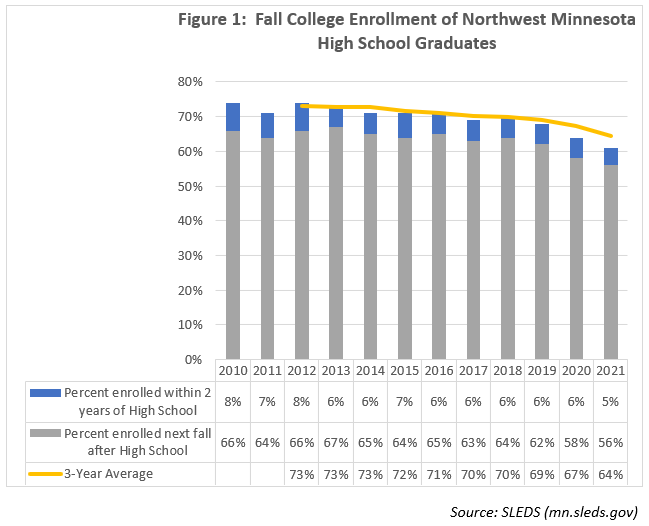 The presence of such industry powerhouses as Polaris, Arctic Cat and New Flyer make Northwest Minnesota a hub of transportation equipment manufacturing.
The presence of such industry powerhouses as Polaris, Arctic Cat and New Flyer make Northwest Minnesota a hub of transportation equipment manufacturing.
From wheat and potatoes to soybeans and sugar beets, the region is a major producer and processor of food staples and specialty agricultural products.
Want the freshest data delivered by email? Subscribe to our regional newsletters.
8/22/2023 9:00:00 AM
Anthony Schaffhauser
With August comes back-to-school planning, and so this should be the right time to examine college enrollment in Northwest Minnesota. The Minnesota Statewide Longitudinal Education Data System (SLEDS) provides student data from pre-kindergarten through completion of postsecondary education and into the workforce. Like most areas throughout the nation, college enrollment in Northwest Minnesota is shrinking. (See Figure 1.)

The impact of COVID-19 is apparent from the sharp enrollment drop off in 2020 and 2021. The pandemic significantly disrupted higher education as remote learning was quickly expanded (often improvised) while the campus experience dissolved, and the tuition cost stayed the same. Enrollment of high school graduates (within two years of graduation) dropped a full seven percentage points from 2019 to 2021.
However, enrollment had already started to tail off starting about 2015. The three-year-average percentage stayed constant from 2012 to 2014, and then dropped almost one percentage point each year through 2019. Rising tuition costs, concerns about student debt, and, a strong job market contributed to this trend.
If this downward trend in enrollment continues solely due to graduates going to work, then this might be characterized as a necessity to fill the region's need for employees. To corroborate this, my previous analysis of workforce demographics (using QWI data) shows growth in jobs held by youth. However, jobs held by those aged 19 to 21 expanded by just 1%, while jobs held by those aged 14 to 18 expanded over 20%. This smaller increase in age 19 to 21 may simply reflect the fact that most college students already had jobs, albeit often part-time or intermittent.
It is reasonable to expect that postsecondary enrollment of high school graduates would stabilize because there are many careers that students pursue that require higher education. There are also signs that the exceptionally tight labor market is starting to ease.
Contact Anthony Schaffhauser at anthony.schaffhauser@state.mn.us.